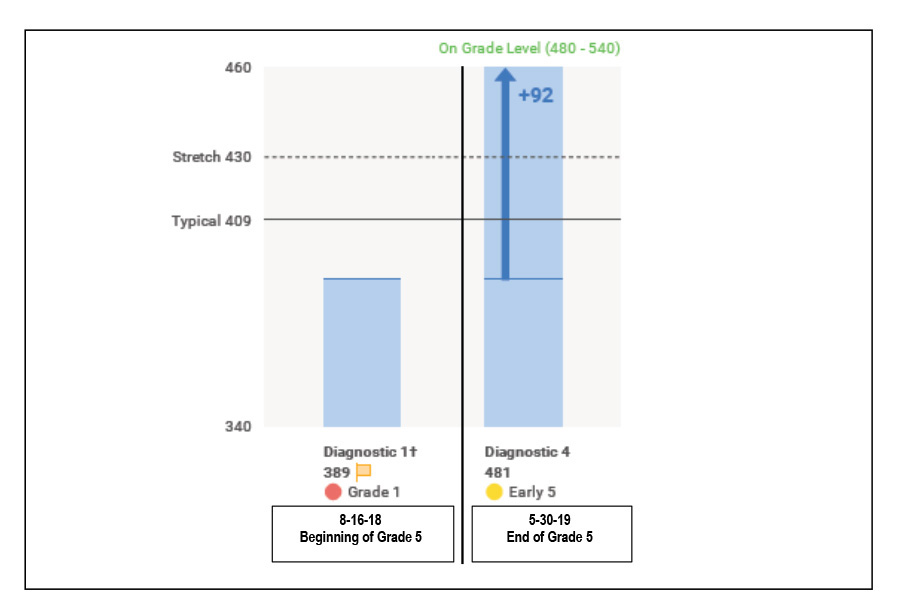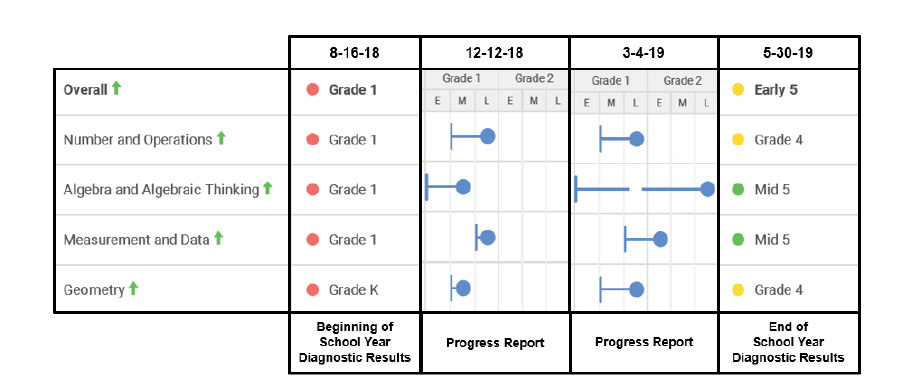News
Special Ed Success in Hawai‘i
Zed’s success using ORIGO Stepping Stones in Hawai‘i
This is the true story of student “Zed” and his remarkable Mathematics advancement in just one semester of using solid ORIGO Stepping Stones instruction.
Zed is a Special Education / English Language Learner in Hawai‘i. When the 2018-19 school year began, he enrolled in Grade 5 at a school that was new to him. It was a fresh start. In August, he took the i-Ready diagnostic assessments. His Math skills were at the Grade 1 level. (See his August 16, 2018 results in Fig. 1). With the aid of the Stepping Stones curriculum, by the end of the school year, his diagnostics indicated “460% progress towards annual typical Math growth for a student at this grade and placement level,” and “224% progress towards his stretch growth,” (an ambitious but attainable level of annual growth).
I feel confident in attributing such impressive advancement to the Stepping Stones curriculum because this unintentional experiment had one significant variable: not following the Stepping Stones curriculum in the first semester versus following the Stepping Stones curriculum in the second semester.
Fig. 1: Zed’s Math Diagnostic Assessment Levels Before and After using Stepping Stones.
Click image to enlarge.
First Semester Instruction
At the beginning of School Year 2018-19, Zed re-entered public school after a year of being homeschooled with tutors. He’d morphed from a 10-year-old who couldn’t read “dog,” and was still counting on his fingers to add 2+2, into a kid who could read, write, do Math word problems, work a computer fairly well (touch typing and keyboard shortcuts included), write in cursive, read a map, and tie his shoes. In August 2018, Zed enrolled in Grade 5 and took his first Math and Reading diagnostic assessments of the new school year. They affirmed what we at home knew. He could read at Grade 2 level, and he was at Grade 1 level ability in Math. For the first time in his life, we got him to a neurologist who diagnosed his learning difficulties as a developmental delay and attention deficit disorder (inattentive type). This meant there was hope for improvement and growth. He is capable of learning. The problem is that his progress was delayed, and he has a natural tendency to be inattentive. Great news! These barriers can be overcome.
Because Zed was placed in Grade 5 according to his age, the Special Ed teacher was attempting to teach him the Grade 5 Stepping Stones Math curriculum while “supplementing” it with other ways of doing so. This was a mistake.
For the first half of the academic year, Zed languished at Grade 1 level Math ability. He wasn’t making connections from one concept to another much less applying abstract formulas to real‑world math applications. Random skills were being thrown at him which were far beyond his capability. His classwork and homework were peppered with worksheets downloaded from multitudinous internet sources whose purpose seemed aimed at force-feeding him rote procedures needed to work abstract math equations related to Grade 5 Math Common Core Standards, but little else. There were occasional instructions from the teacher to watch some Khan Academy videos which seemed irrelevant and unconnected to his lesson of the day.
By the end of the first semester, Zed’s Math ability had not progressed beyond Grade 1 performance. (See December 12, 2018, Progress Report in Fig. 2.)
Fig. 2: Zed’s Math Domain Advancement Throughout the School Year.
Click image to enlarge.
Concerned by Zed’s lack of progress, I met with the school’s Curriculum Coordinator to find out more about Stepping Stones. He introduced me to the SS DTE (Digital Teachers Edition/Slate) with all its fabulous differentiation resources available online in one complete software package. That’s when everything began to change for the better.
A New Direction in the 2nd Semester
Transitioning to full implementation of Stepping Stones was rocky initially. For example, I asked for permission to come to the school to study the SS DTE, but my request was denied. The excuse was that we shouldn’t have access to the curriculum assessments. “So what?” I wondered but didn’t have the time and energy to argue. My employee evaluations aren’t tied up to how well he does on his Math assessments. I have no interest in giving Zed answers to merely pass a test; I want him to learn.
So, I laud ORIGO and give my greatest thanks to their enlightened minds. ORIGO sold us a Stepping Stones DTE license and saved the day. It was like John Wayne galloping in and protecting the little ones. All parents should be allowed to buy a copy of their child’s professionally-written curriculum if they want to! It’s capitalism at its best, and doing this enables parents and tutors to see the myriad comprehensive components that comprise their child’s curriculum.
Once we had access, we discovered how much of the well‑written Stepping Stones curriculum Zed was missing. Half of the school year had gone by and Zed had never even seen any of the Flare tools. He’d was assigned pages in the Grade 5 Student Journal but had not covered them yet in class. It was time for a change.
First, we convinced the Principal that the teacher should be using the Stepping Stones curriculum and only the Stepping Stones curriculum. Charging out of that gate, the teacher began “differentiating” the Grade 5 curriculum by stepping backwards through the “Previous Lesson” feature in the DTE. This is a great feature (sequence navigator) that helps teachers wind their way back through a Math concept as it was taught in Grade 4, Grade 3, etc, in the event some reinforcement of a concept is apropos. It no doubt works well with students who need mild reinforcement. The problem with this approach was that for a SpEd student performing several levels below his age-related peers, there were so many pukas (holes) in his prior knowledge that for each successive Grade 5 lesson we had to take too many steps backwards. It was a confusing stew for Zed and those of us at home trying to help him.
In January, we convinced the Principal that Zed should start at his level of capability/challenge and move forward from there. Grade 3 Stepping Stones was the level that was challenging for him, but he had enough background knowledge to successfully master the new material. I commend the Principal for this bold move because in Hawai‘i, it’s a bit revolutionary. In too many cases, if the child is enrolled in Grade 5 then, by gum, he’s gonna be taught Grade 5 standards whether or not he can do Grade 3 or Grade 4 work. Of course, that approach is doomed to fail. If you don’t build a strong foundation, the house eventually collapses. A strong foundation, like a rock, like a stone, is especially important in Math education which builds from basic skills at the bottom up to more advanced math. Even the title, Stepping Stones, is aligned with the educational philosophy of stepping higher and higher on a solid (stone) foundation. I get it, and the gettin’ is good.
Once the school agreed, we zoomed through Grade 3 material he already understood while delving deeper into the myriad differentiation resources on concepts with which he was unfamiliar or struggled. In all cases, even with skills he already grasped such as addition, the “More Math Problem Solving Activities” helped him truly understand why he was learning a Math specific skill. The word problems, visuals, and real-life problems at every turn in the curriculum were amazing.
Powering through the Stepping Stones Grade 3 curriculum at Zed’s optimal pace gave him the solid Math foundation he needed to progress even faster as time when on. His learning accelerated rapidly. As you will see in Fig. 2, once we got the teacher on board with the program by the end of February, Zed broke through the Grade 1 barrier in March, and by May, the results shown in the data above were world-class.
Lessons Learned
The past few years, the State of Hawai‘i Board of Education and Department of Education have noticed that the achievement gap between Special Education students and their age-level peers is not closing, maybe even widening. Adopting the role of a SpEd parent’s assistant the past couple of years has given me a clear picture of why. Here’s what I believe needs to happen to close the mathematics gap for SpEd students.
First and foremost, SpEd teachers must be required to follow a professionally-written curriculum to teach Mathematics, especially at the elementary and middle school level. The battle cry for school empowerment has merit, but for SpEd students, it is a disaster if it means that teachers with little experience even teaching are writing their own curricula, too. I don’t doubt that there are a few who might be capable of doing this, and there should be some way to have teacher-created curricula vetted by a committee (not just a Principal) in these rare cases, but I don’t think the majority of Hawaii’s teachers are good curriculum developers. Last year wasn’t an isolated experience. Zed has another provisionally-licensed teacher again this year for Grade 6. She’s not following the school’s chosen Math curriculum claiming she’s supplementing with worksheets to meet his IEP, and not using the differentiation materials I suspect are in the curriculum but haven’t been allowed to see yet. I predict that a mid-year diagnostic assessment, if the school is willing to do one, will show little improvement since August, just like the end of the first semester last year.
Following a curriculum means starting at the student’s level of capability & challenge and moving forward, step by step through the curricula. Special Education students need to catch up, not be dumped at some point in the learning curve based on their age, and be expected to perform well with huge gaps in their background knowledge. SpEd students also need a well-organized curriculum so they can see where they’ve been and where they are going. This is the best way to connect home learning, too. Parents need to be able to follow a curriculum, and streams of worksheets just doesn’t cut it.
Second, teachers should have to become certified teaching the school-chosen curriculum and be proven competent to do so. One day of training does not an expert make. All last year, every time we had to counter the novice teacher’s excuses for not using a professionally written curriculum because she had a Master’s degree in education, Alexander Pope’s rhyme reverberated in my brain. “A little learning is a dangerous thing; drink deep, or taste not the Pierian spring: their shallow draughts intoxicate the brain, and drinking largely sobers us again.” It turns out she’d had only one day of Stepping Stones training before being expected to teach it in the classroom. It’s not possible to do a good job under these circumstances and the false sense of being an expert after one day of training is counterproductive.
Lastly, I highly recommend Stepping Stones for Special Ed students for several reasons. The helical structure of the curriculum is brilliant. You don’t start on one subject, study that for a month, go to the next subject and study that for a month so that by the end of the year the SpEd kid with a bad memory has forgotten what he learned in October and November. All the standards are visited and revisited with increasing complexity as students work through the lesson steps. The word problems, visual approaches, online manipulatives, and videos were extremely helpful and engaging. From a teacher’s perspective, the DTE made every Stepping Stones lesson from K-6 easy to access. From a parent’s perspective, it was great to be able to buy a DTE lesson and help Zed at home. I so wish his Middle School used Stepping Stones.
______________________________________________
Vanessa Ott is a privately-contracted piano teacher. She is a former Hawai‘i certified elementary school teacher, communications IT specialist, and hi-tech magazine editor. Since 2017 she has volunteered to tutor Zed, and assist his non-native-English-speaking mother advocate for her son’s academic progress. Ms. Ott is not affiliated with ORIGO Education and has received no monetary remuneration for this article.



